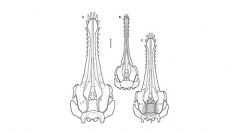

 Comptes Rendus Palevol
12 (7-8) - Pages 519-530
Comptes Rendus Palevol
12 (7-8) - Pages 519-530Most extant odontocetes appear to be anosmatic. However, some Miocene odontocetes, including a broken skull attributed to Squalodon sp. (Calvert Formation, Calvert Cliffs, Maryland, USA) preserve the osteological components associated with a well-developed sense of smell: dorsal nasal meatuses, ethmoturbinates within olfactory recesses, a perforate cribriform plate, and an olfactory bulb chamber. In Squalodon sp., the area within the olfactory recesses (i.e., covered in life by olfactory sensory epithelia) is 5367 mm2 and the area occupied by the olfactory bulbs (i.e., the ethmoid area) is 769.8 mm2. In most mammals, the area of the olfactory epithelium is typically circa 16 times larger than the ethmoid area. The area covered by olfactory epithelium in CMM-V-2287 is only about seven times larger than its ethmoid area, less than half the area in typical mammals. During the Miocene, most odontocetes variously lost the osteological proxies indicative of osmatic ability. Perhaps biosonar surpassed the efficiency of olfactory cues during predation and social/parental/sexual interactions rendering the latter redundant/obsolete in odontocete analysis of, and interactions with and within their aquatic environments.
Squalodontidae, Odontoceti, Olfaction, Miocene, Calvert Formation, Ethmoturbinates